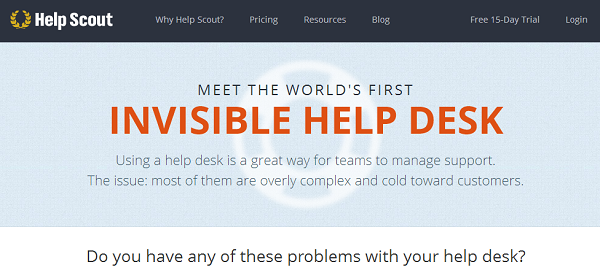Who are your ideal clients?
As a freelancer, do you know which sorts of people are a perfect fit for your business… or are you just winging it?
If it’s the latter, it is time you look into customer profiling, one of the absolute BEST freelance marketing tactics available that will help you land the clients and gigs that matter.
Fact is, most freelancers likely don’t do this because it seems like a lot of work, but if you use the simple template I’ll show you below, you’ll find out that it’s a breeze.
Let’s get started…
Step #1 — Create a Broad Description of One of Your Ideal Buyers
This is the most vague piece of advice in the entire post, and I’ll break it down much further, so don’t worry. 🙂
Just like any good business breaks down their primary buyers (and you should be treating your freelance work like a business), you need to identify a broad description of some of your ideal clients.
To show you a real example, here’s a customer profile we use at Help Scout, which focuses around an up-and-coming entrepreneur (one of our ideal buyers):
Although this is a broad description of “Graham” (it’s supposed to be, we’ll get into more detail later), we already know a few things about him…
- He is the decision maker in his company, and he will likely sign up himself.
- His team probably includes 10 people, so he is a small company but growth focused (scale matters to him).
- Customer service is something he identifies as a selling point for his business, so he will likely be very interested in the content we publish on the Help Scout blog.
Although this example is for a product business, you can do the exact same thing for a freelance operation as well — I should know, I do it myself!
As a content strategist for software startups, I would identify one of my ideal customers as someone like “Startup Steve,” who runs a SaaS business with >15 people and who understands the value of content, but doesn’t know how (or doesn’t have time) to execute.
This “Startup Steve” has typically been in business for more than 2 years and might have funding, and will largely be interested in details like optimizing content for search and list building to acquire more customers via email marketing.
Having even just this basic idea of a customer type I should be going after helps me in my marketing efforts (where I should appear, who I should create content for), how I craft my client testimonials, who I send my SEO proposal to, and even who I network with.
But let’s take this a little further…
Step #2 — Identify Their End-Goal Wants & Needs
Once you’ve nailed down a few ideal customer profiles, it’s time to start enhancing your template.
To simplify this, I essentially boil down the customer’s viewpoint into these two options…
- What is this client’s ideal goals or end-result from your services?
- What are the most important “features” of a service like this in their eyes?
By the way, you can and should have some influence here when a client is focused on the wrong things (sounds scary, but I’ll show you what I mean in a second).
Since I follow this structure personally, let’s take this back to me — as a content strategist, my clients are looking for well-written content that achieves the following ends:
- Makes their company blog look like an authority
- Provides valuable information for potential customers, using education to showcase why their software is useful
- Generates qualified traffic and leads to the site and their newsletter
When clients come to me with goals like, “We want a blog post that will get a lot of tweets,” I educate them on what’s really important. If they don’t get it, we probably aren’t a match for each other, because my ideal client (“Startup Steve”) already knows about content marketing and trusts me to deliver practical results, not vanity metrics.
After you’ve covered ideal end-goals for this particular customer profile, it’s time to move on to what “features” they value the most from your business. This should be the logistical stuff that they will care about above all else.
For instance, Ramit Sethi, founder of I Will Teach You To Be Rich, is always ranting and raving about how many freelancers focus on things that many ideal clients won’t care about. He says that if you want to work with him (as a web designer), he cares more about turn-around time, availability, and work speed over the details like typography. That’s because he is a marketer who needs to move fast.
As another example, Ruben Gamez, the founder of Bidsketch, is a guy who prefers to utilize his talents towards running and improving his product, and this comment from him should be a dead giveaway for what he wants out of content strategy…
“Writing and editing are like pulling nails for me, man.”
That should tell you that when it comes to writing articles for the Bidsketch blog, he’d rather have everything “good to go” and ready to go live for publish day, he’s not a client that wants to get hands on with content formatting or input (so I take care of it).
What are some project elements that your clients really care about?
Cater your packages around these needs, reflect the fact that you “get it” in your copy.
Step #3 — Identify Where this Person Frequents
The third and final step in this simple client profile template is to identify where this ideal customer frequents, and what interests they have that can be utilized in your client acquisition efforts.
I usually think about things from 3 separate angles…
- What online publications does this person read?
- What sort of search terms are they likely to use?
- Where is an ideal place for them to “land” on my website?
Let’s break it down!
1.) What Sites they Read
I went over in my freelancing marketing breakdown how, early on when you can’t rely on “word of mouth” marketing for your services, you need to show up on other sites in order to grow your business.
The thing is, you can’t just “spray and pray,” firing away random guest posts and features in hopes that you’ll pick up a customer or two.
You need to get tactical, because you don’t have all day to do this stuff, you actually have freelance work to get done!
The BEST way to do this is to work within your customer profile… for example, what popular blogs, podcasts, and other web content will this ideal customer consume on a regular basis?
Here’s a candid example — When guest posting for Bidsketch, Ruben and I will end up on places like Six Revisions or Guerrilla Freelancing, because we know those are sites that freelancers are likely to visit.
It would be a waste of time to guest post for BuzzFeed or other random sites with ridiculously high pageviews because it would be wasted traffic, nobody from those sites would care about freelancing or creating better proposals.
2.) What Search Terms will they Use?
This is a great way to brainstorm for SEO title tags on your site, but more importantly, it’s a great way to find out what sort of content you should be creating!
On Bidsketch, terms like “web design proposal” and “business proposals” are constantly bringing in new leads and customers because they give how-to guides on things that people want to know about and they are highly relevant to what Bidsketch sells.
What about your ideal customers? What sort of terms will they be looking for?
It’s important to consider because your multiple customer profiles could be searching for vastly different terms.
For instance, if you handle both personal branding and web design for clients, you’re going to have people searching for two distinct things right there (those wanting a full personal re-brand and those who just want a website).
You need to think about terms that each customer archetype will likely use, and then have the content on that page reflect their needs and wants.
Which brings me to my last point…
3.) Where Should they “Land” on your Site?
One thing that many freelancers skip is that they don’t create landing pages tailored to particular clients.
How many times have you seen this…
Branding, design, logo creation, I do it all!
…uh, good for you, but I don’t want it all, I probably just want a problem solved, fast.
And I need to evaluate whether or not you are the person to do it, yet I get a generic pitch on your homepage (with no way to narrow down my interest) and your portfolio can’t be organized by project type.
Instead, you can create separate landing pages for different customer profile types to ensure that the things they are worried about get addressed.
For “Growth Graham”, who I showed you earlier, at Help Scout we have a dedicated email support page, because Graham is likely coming from Gmail or a personal inbox:
However, for another one of our customer profiles, “Helpdesk Heidi”, this problem with email is non-existent because she likely is already using a help desk provider.
So we have a separate page for people like her:
Why bother with an entirely separate page?
Because it’s a very different customer who has different concerns!
If you have distinct customer differences like “Growth Graham” and “Helpdesk Heidi”…
…then you MUST take advantage of having different places for them to “land” and hear your pitch as to why you are the person that can solve their unique problems.
No more, “I’m web designer #342029”, if you have a ton of clients who are lawyers, or who operate churches, or who run asparagus restaurants (hey, you never know!), be sure to build pages that ask and answer the problems these particular clients will have!
Building a customer profile template will allow you to do this easily, so make sure you tackle that first.
Your Turn
Answer the following questions for me…
- Do you (or your team) have any customer profiles prepared yet? How useful are they to your freelance business?
- Will you be creating customer profiles now? Let me know so I can brag about it! 😉
Thank you for reading, I’ll see you down in the comments!






